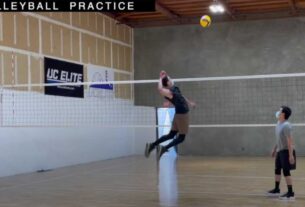Softball is a bat-and-ball game played between two teams, with the primary objective of scoring more runs than the opposing team. In order to score a run, a player must successfully touch each base in a specific order and reach home plate safely.
However, there are situations where runners must make a split-second decision to “tag up” and advance to the next base. Tagging up is a crucial aspect of the game that requires knowledge, timing, and awareness of the situation.
What Is Tagging Up in Softball?
Tagging up in softball refers to a baserunner’s action of retouching their original base after a fly ball is caught by a defensive player.
When a fly ball is caught, runners who were on base at the time must “tag up” by returning to their original base before attempting to advance to the next base. Failing to tag up properly can result in being called out by the umpire.
Why Is Tagging Up Important in Softball?
Tagging up is important in softball for several reasons:
- Avoiding Double Plays: By tagging up, baserunners can avoid being caught off the base and potentially falling victim to a double play. By returning to their original base, runners create a “safety net” and increase their chances of advancing safely.
- Scoring Opportunities: Tagging up allows baserunners to take advantage of scoring opportunities. By observing the fly ball and timing their return to the base, runners can position themselves to advance and potentially score a run when the opportunity arises.
- Respecting the Defense: Tagging up is a way of showing respect to the defensive players. By retouching their original base, runners acknowledge the defensive effort and avoid unnecessary conflicts or confrontations.
- Game Strategy: Tagging up is a strategic move that can be employed by coaches to gain an advantage over the opposing team. By forcing the defense to make quick and accurate throws, coaches can put pressure on the fielders and potentially create errors or misplays.
When Should You Tag Up in Softball?
Knowing when to tag up in softball is crucial for baserunners. Here are some common situations where tagging up is typically employed:
- Fly Balls to the Outfield: Whenever a fly ball is hit to the outfield, baserunners should assess the situation and determine whether tagging up is feasible. If the outfielder catches the ball deep or the ball is hit with less velocity, tagging up becomes a viable option.
- Shallow Fly Balls: In cases where the outfielder catches a shallow fly ball, baserunners need to evaluate the situation carefully. If the runner is confident in their speed and believes they can advance to the next base safely, tagging up might be a strategic move.
- Sacrifice Fly Situations: In sacrifice fly situations, where a runner on third base attempts to score after a fly ball is caught, tagging up is necessary. The baserunner must retouch the base before sprinting towards home plate to ensure the run counts.
- Runner positioned on first base and a Fly Ball: In the scenario where a baserunner finds themselves stationed on first base and a fly ball is subsequently launched, it becomes imperative for the baserunner to exhibit acute situational awareness. If the ball is caught, the runner has the option to tag up and advance to second base if the opportunity arises.
How to Properly Tag Up in Softball?
Properly tagging up in softball involves a combination of timing, awareness, and quick decision-making. Follow these steps to ensure you execute a successful tag up:
- Identify the Fly Ball: As a baserunner, your first task is to identify whether the ball is a fly ball that is likely to be caught. Observe the trajectory and distance of the hit to make an informed decision.
- Prepare to Retreat: Once you determine that the ball will likely be caught, immediately shift your focus to retreating back to your original base. Take a few steps back and position yourself for a quick return.
- Time Your Return: As the fielder catches the ball, watch their movements and anticipate the moment when they secure the catch. This is your cue to start running back towards your base.
- Retouch the Base: As you reach your original base, ensure that you touch it with any part of your body before attempting to advance to the next base. This action signifies that you have tagged up properly.
- Advance if Safe: After retouching your base, assess the situation to determine whether advancing to the next base is a viable option. Consider the arm strength of the fielder and the distance you need to cover.
- Be Ready to React: If you decide to advance, be prepared to react quickly to any throws or defensive plays. Keep an eye on the ball and be ready to adjust your running path or slide if necessary.
Frequently Asked Questions (FAQs)
Can a runner score if they tag up after a catch?
Yes, a runner can score if they tag up properly after a catch. If the baserunner retouches their original base and then advances to the next base after the catch, they can continue running and attempt to score.
What happens if a runner fails to tag up in softball?
If a runner fails to tag up properly in softball, they can be called out by the umpire. Once the ball is caught, the runner must retouch their original base before attempting to advance. Failing to do so allows the defense to appeal the play and potentially get the runner called out.
Can a runner tag up on a foul ball in softball?
No, a runner cannot tag up on a foul ball in softball. In order for a runner to tag up and attempt to advance, the ball must be fair when caught by the fielder. If the ball is foul when caught, baserunners must return to their original base, and no advancement is allowed.
What is an appeal play in softball?
An appeal play in softball is a defensive action taken by the fielding team to request a ruling from the umpire regarding a potential base running violation. If a runner fails to tag up properly or misses a base, the defense can appeal the play by tagging the base or by throwing the ball to the base before the runner returns.
Can a runner tag up on a line drive in softball?
Yes, a runner can tag up on a line drive in softball. As long as the ball is caught by a fielder before it touches the ground, the baserunners have the opportunity to tag up and attempt to advance.
Is tagging up required on every fly ball in softball?
No, tagging up is not required on every fly ball in softball. Baserunners must use their judgment to determine whether tagging up is advantageous based on the situation. If the fly ball is hit deep or if the runner believes they can advance safely, they may choose to tag up.
Conclusion
Tagging up in softball is a crucial aspect of the game that requires baserunners to make split-second decisions and demonstrate their awareness of the situation. By retouching their original base after a fly ball is caught, runners can position themselves for scoring opportunities while avoiding unnecessary risks.
Understanding the rules and strategies of tagging up is essential for players, coaches, and fans alike. So, next time you’re on the softball field, remember to keep an eye on those fly balls and make the right move by tagging up!



